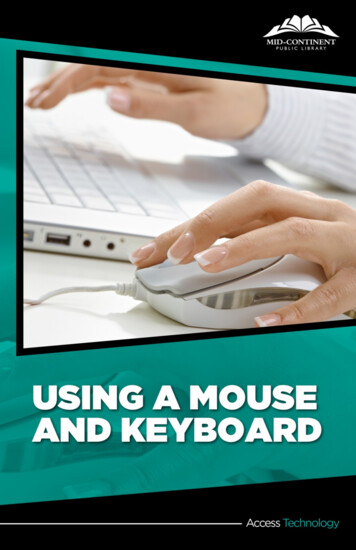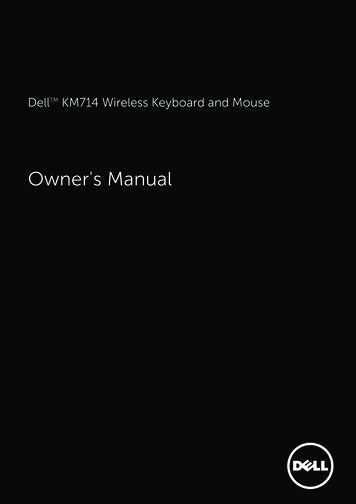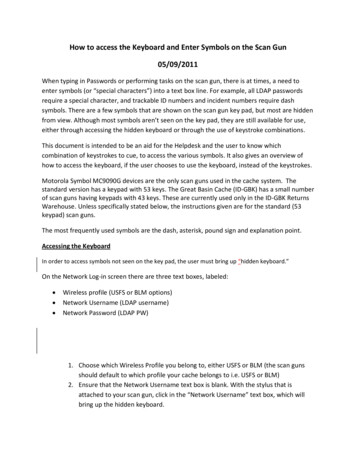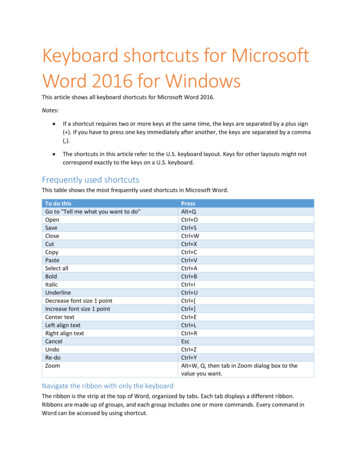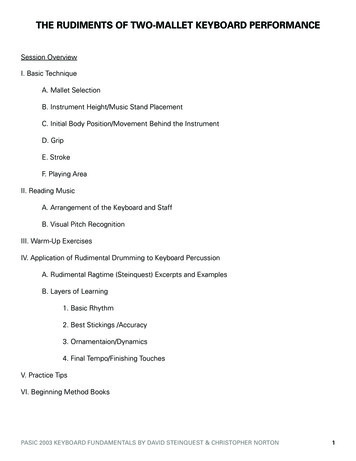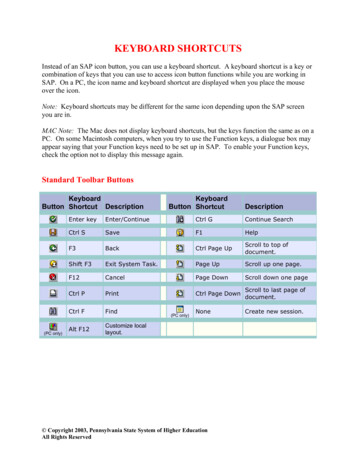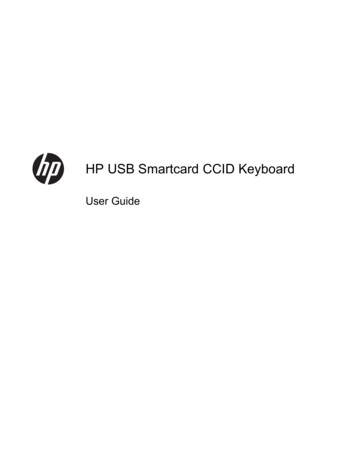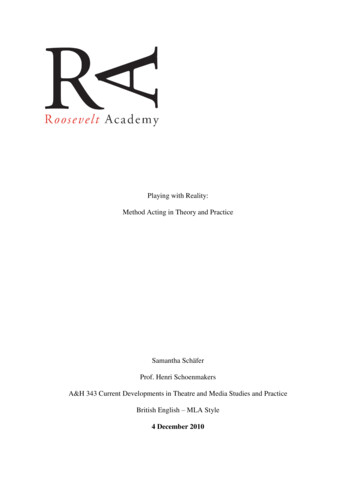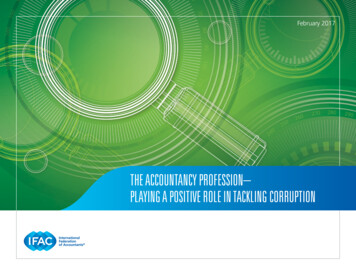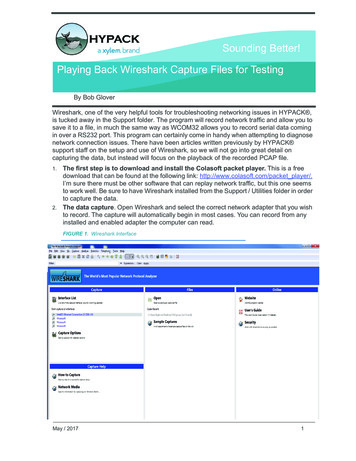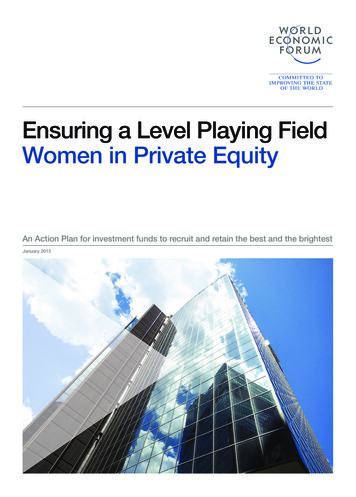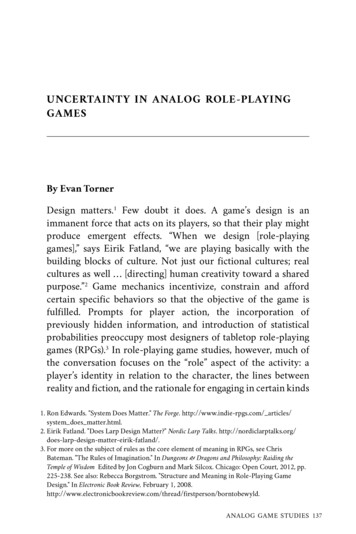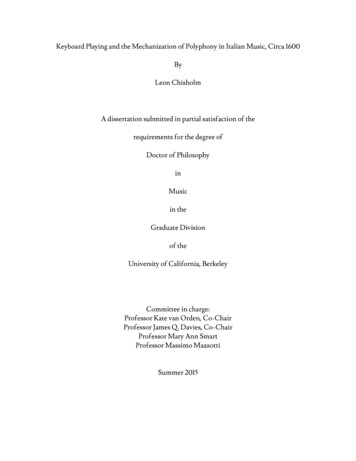
Transcription
Keyboard Playing and the Mechanization of Polyphony in Italian Music, Circa 1600ByLeon ChisholmA dissertation submitted in partial satisfaction of therequirements for the degree ofDoctor of PhilosophyinMusicin theGraduate Divisionof theUniversity of California, BerkeleyCommittee in charge:Professor Kate van Orden, Co-ChairProfessor James Q. Davies, Co-ChairProfessor Mary Ann SmartProfessor Massimo MazzottiSummer 2015
Keyboard Playing and the Mechanization of Polyphony in Italian Music, Circa 1600Copyright 2015byLeon Chisholm
AbstractKeyboard Playing and the Mechanization of Polyphony in Italian Music, Circa 1600byLeon ChisholmDoctor of Philosophy in MusicUniversity of California, BerkeleyProfessor Kate van Orden, Co-ChairProfessor James Q. Davies, Co-ChairKeyboard instruments are ubiquitous in the history of European music. Despite the centralityof keyboards to everyday music making, their influence over the ways in which musicians haveconceptualized music and, consequently, the music that they have created has received littleattention. This dissertation explores how keyboard playing fits into revolutionarydevelopments in music around 1600 – a period which roughly coincided with the emergenceof the keyboard as the multipurpose instrument that has served musicians ever since. Duringthe sixteenth century, keyboard playing became an increasingly common mode ofexperiencing polyphonic music, challenging the longstanding status of ensemble singing as theparadigmatic vehicle for the art of counterpoint – and ultimately replacing it in the eighteenthcentury. The competing paradigms differed radically: whereas ensemble singing comprised agroup of musicians using their bodies as instruments, keyboard playing involved a lonemusician operating a machine with her hands. By replacing musicians with a machine,keyboard playing amounted to a mechanization of polyphony.Chapter 1 outlines the mechanization of ars perfecta polyphony through keyboard playing. Toillustrate its effects, I analyze several keyboard intabulations in relation to their vocal models,including Marcantonio Cavazzoni's adaptation of the chanson Plusieurs regretz by Josquin,and the intabulation preserved in the Turin Tablature of Rore's Calami sonum ferentes. I showhow formal differences relate to changes in agency, script, and sensorimotor experience.Drawing on research in cognition and motor control, I discuss how experiencing polyphonicvocal music through keyboard playing affected how musicians parsed the art form. Theremainder of the dissertation examines the relationship between keyboard playing and theecclesiastical concerto, as exemplified in Lodovico Viadana's Cento concerti ecclesiastici1
(1602). Chapter 2 investigates the complex material relationship between the vocal partbooksand organ continuo part in printed books of sacred music from the 1590s and early decades ofthe seventeenth century. I argue that the concerto print served as a virtual site for theconvergence of the art of counterpoint and keyboard playing. Chapter 3 proposes that theredesign of the Italian organ in the fifteenth and sixteenth centuries was a crucial precedentfor the "concertato style." The concertato style itself represents a stylization of the model ofdistributed cognition inherent in the sacred concerto.2
To my parents, Jim and Judy, with gratitudei
TABLE OF CONTENTSList of FiguresList of Musical ExamplesList of TablesAcknowledgementsLibrary SiglaPitch NomenclatureiiivviiviiixxiIntroduction: Cyborgs at Work11 Intabulation and the Mechanization of Polyphony202 Basso Continuo and the Transformation of the Printed Book of Sacred Music713 Material Origins of the Concertato Style109Bibliography146Appendix A Transcriptions of Plusieurs regretz and Plus ne regres167Appendix B Transcriptions of Calami sonum ferentes172Appendix C Printed Collections of Sacred Music with Organ Parts, 1594-1605178Appendix D Reeditions of Single-Author Prints of Sacred MusicNewly Issued with a Continuo Part, 1601-1693192Appendix E Anthologies Including Older Sacred Music Newly Issued with aContinuo Part, 1599-1639195ii
LIST OF FIGURES0.1. G.F. Cavalliere, Juxtaposition of mano figurata and keyboard.121.1. Josquin, Plusieurs regretz, from Livre contenant XXX. chansons tres musicalesa quatre, cinque & six parties (Paris: Pierre Attaingnant, 1549).341.2. M. Cavazzoni, Plus ne regres, from Recerchari, motetti, canzoni (Venice:Vercelensis, 1523).351.3. Rore, Calami sonum ferentes, Tutti i madrigali di Cipriano di Rore (Venice:Gardano, 1577), opening.421.4. Rore, Calami sonum ferentes, excerpt (I-Tn, Ms. Foà 4, f. 62r).431.5. Distribution of pitches among the four parts of Calami sonum ferentes asa) Rore's vocal setting, and b) the intabulation in the Turin Tablature.451.6. Distribution of rests among the voices in a) the original version of Calamisonum ferentes by Rore, and b) the intabulation of the work in theTurin Tablature.471.7. Berchem, Lasso che desiando vo as appearing in a) Il secondo libro de madrigalidi Cipriano de Rore a cinque voci insieme alcuni di M. Adriano & altri autori(Venice: Gardano, 1544/1551R), and b) Bardini Manuscript 967.501.8. Correa, Facultad organica, example of cifra notation and pointers.512.1. Notational formats of basso continuo parts in partbook sets.832.2. Luigi Balbi, Ecclesiastici concentus (Venice: Raverius, 1606), title pages ofthe Altus partbook and Partidura.952.3. Signorucci, Salmi, falsobordoni (Venice: Vincenti, 1603), title pagesof Canto II and Basso per sonar.983.1. G.B. Martini’s sketch of a medieval organ with other instruments.1323.2. Zarlino, Sopplimenti musicali, woodcut of a medieval organ windchest.133iii
3.3. Praetorius, De organographia, woodcut of the manual and pedal keyboards ofthe Halberstadt organ.1343.4. Praetorius, De organographia, woodcut of a key of the Magdeburg organ.1353.5. Matteo d’Allemagna, sketch of the proposed organ for S. Antonio, Cremona.1363.6. Alternating forces in Lappi, Te Deum, mm. 45-103.1413.7. Basso generale from G. Gabrieli, Canzon vigesimasettima of Canzoni per sonare. 143iv
LIST OF MUSIC EXAMPLES1.1. Comparison of Plus ne regres and Plusieurs regretz, opening.281.2. Comparison of Plus ne regres and Plusieurs regretz, mi-fa-mi motif.291.3. Josquin, Plusieurs regretz, mm. 24-30.301.4. Josquin, Plusieurs regretz, mm. 8-9.311.5. a) Josquin, Plusieurs regretz, mm. 16-17, b) Cavazzoni, Plus ne regres, mm. 15-16.311.6. Josquin, Plusieurs regretz, canon a) mm. 3-7, b) mm. 24-28.321.7. Josquin, Plusieurs regretz, mm. 7-9.361.8. M. Cavazzoni, Plus ne regres, a) mm. 11-12, b) mm. 20-22.361.9. M. Cavazzoni, Plus ne regres, mm. 30-31.361.10. Willaert, Qui la dira la peine de mon cœur a 5, canon, mm. 4-8.381.11. Qui la dira la peine de mon cœur, mm. 3-5, a) Willaert, b) A. Gabrieli.391.12. a) Josquin, Faulte d'argent a 5, opening, b) hypothetical literal transcriptionfor keyboard, c) G. Cavazzoni, Canzon sopra Falt d'argens, opening.411.13. Rore, Calami sonum ferentes (mm. 7-10) as it appears in a) Le quatoirsiesmelivre a quatre parties (Antwerp: Susato, 1555), b) I-Tn Ms. Foà 4.441.14. Luzzaschi, Quivi sospiri, Tenor, mm. 10-13.561.15. Diruta, Il Transilvano, fingering.641.16. Correa, Tiento de medio registro de dos tiples de septimo tono, Facultadorganica (1626), mm. 25-30.661.17. Bimanual coordination exercises.67v
2.1. Modern categories of basso continuo. a) "Basso continuo" in Gian Paolo Cima,Haec dies, Concerti ecclesiastici (Milan: Tini & Lomazzo, 1610), excerpt;b) "Basso seguente" in Gabriello Puliti, Credo, Missa concertata, fromIl secondo libro delle messe (Venice: Vincenti, 1624).782.2. Banchieri, Quinta Sinfonia ("Sacerdotes, & Levitę"), Ecclesiastiche sinfonie(Venice: Amadino, 1607), mm. 18-20.793.1. Lappi, Te Deum a 8, excerpt (as performed a cappella).1123.2. Lappi, Te Deum a 8, excerpt (as performed according to rubrics).114vi
LIST OF TABLES1.1. Comparison of the unmechanized (vocal) and mechanized (keyboardal)performance of polyphonic music.572.1. "Bilingual" early sacred concerto prints.93vii
ACKNOWLEDGEMENTSFor financial support of this dissertation, I thank the University of California,Berkeley, particularly the Department of Music, Graduate Division, Townsend Center forthe Humanities, and Berkeley Connect. The Alfred Hertz Traveling Fellowship allowed meto study the cembalo cromatico and its more ordinary relatives with Christopher Stembridge.A fellowship from Fondazione Cini permitted me to do research in Venice for six monthswhile living on the island of San Giorgio Maggiore. Through a visiting fellowship fromHarvard University, I had the pleasure of becoming part of another illustrious musicdepartment for a year. The Oshawa Centre of the Royal Canadian College of Organistsgenerously awarded me a scholarship toward my organ studies.The staff at the library of Hargrove Music Library at UC Berkeley provided vitalbibliographic support. I'm indebted also to the staff of the Manica Lunga at Fondazione Cinifor their help. I thank the Loeb Music Library staff for making me feel so welcome during myyear at Harvard. Thanks also to Kathryn Bosi at Villa i Tatti for making my visits there sopleasant.I offer heartfelt thanks to the four remarkable professors who have comprised mycommittee. Kate van Orden has been a model advisor and scholar. She knows exactly when tochallenge me and when to cheer me on. She has read my drafts with incredible dedication andhas always been available to chat, even while working on two books of her own. I'm thankfulfor the magical blend of imagination, rigor, passion, and humor that is the intellect of JamesDavies. Our many conversations – always encyclopedic and lightning-paced – helped bringsome of the principal ideas of this dissertation into focus. One of the greatest gifts of myfinal year at Berkeley was the experience of working closely with Mary Ann Smart throughBerkeley Connect. To her, I'm deeply grateful for the time that she made for me and mygarbled drafts. Her enthusiasm carried me over some major humps, and her dedication toteaching and mentorship leaves a lasting impression. I offer many thanks also to MassimoMazzotti for helping to shape the way I think about history and knowledge creation. Hisinsights from outside musicology have contributed to my understanding of the wider culturalsignificance of specialized topics within musicology, including intabulation.The Berkeley music department has been a bottomless well of intellectual stimulation.In particular, Davitt Moroney nourished my interest in old "stuff" and helped me to hone mywriting. Anthony Newcomb took time to talk with me about my research and generouslyshared his ideas and works-in-progress with me. Nick Mathew and John Roberts weresupportive and always available to chat on wide ranging topics.Jose Neglia and Laura Protano-Biggs provided moral support and comic relief in myearlier years of graduate study; Anicia Timberlake took over that role in our final months ofdissertation writing. The time I've spent with them and many other fellow graduate students– especially Rebekah Ahrendt, Eliot Bates, Esther Criscuola de Laix, Sean Curran, EmilyFrey, Jess Herdman, John Kapusta, Jonathan Rhodes Lee, Adeline Mueller, Emily Richmondviii
Pollock, Sumitra Ranganathan, Kendra Salois, Rachana Vajjhala, and Rachel Vandagriff –have made my intellectual world so much richer. In Cambridge, postdoctoral fellows ScottEdwards and Russ Manitt rescued me from a precarious situation and were great comrades.Raymond Clark (who was my wonderful Classics professor at Memorial University ofNewfoundland during my undergraduate degree) and Emerson Morgan helped me with akey Latin translation. Jennifer MacKenzie helped with some tricky Italian passages.In Italy, my fellow borsisti at Fondazione Cini – Nicola Biondi, Nadia Chamina,Ludovica Piazzi, Francisco Rocca, and Pier Mattia Tommasino – greatly expanded myknowledge of Italian cultural history while helping me improve my Italian. PedroMemelsdorff was a wealth of knowledge on everything, and he and Edo Damanti were verygenerous hosts. Loris Stella shared his immense knowledge of organology and local historywith me between organ crawls and visits to historic sites in the Veneto and Friuli.Friends from the realm beyond university kept me whole during my graduate studies.I'm particularly grateful to Seth Arnopole, Chris Brandes & the late Karla Lemon, HannahGreene, Pattie Hsu & Manu Garg, Kathryn Miller & Andrew Tinka, Jennifer Paulino, andSandra Razieli for their generosity and friendship.During my seven years as organist at St. John's in Berkeley, I got to know an inspiringgroup of local people. And working with Todd Jolly and the choir ensured that the practicalside of music making was always at the forefront of my mind while I was researching andwriting.This dissertation is a partial answer to a question I wondered about as a teenager:where does musical style come from? For nurturing my interest in the cultural context ofmusic from a young age, I owe a great deal to Jane Steele, my piano teacher, lifelong friend,and wonderful human being.My perspective on music history has been fundamentally shaped through my organstudies. My first organ teacher, Ki Adams, made an exception in taking me on and expertlyguided my progress for eight years. Kimberly Marshall helped me discover my musical voice.Spending time with Christopher Stembridge at his home in South Tyrol helped me to see oldthings in an utterly new way.Toward the end of the dissertation, I met Steffi Probst, who has become an incrediblepartner. She set aside her own work to read drafts, copy edit, and check bibliographicinformation for me. Her love and unwavering faith in me saw me through to the end.Finally, I am deeply grateful to my family for all they have given me. Jill and Nick havebeen such generous, delightful siblings to their perpetual-student older brother. My biggestheroes are my parents, to
conceptualized music and, consequently, the music that they have created has received little attention. This dissertation explores how keyboard playing fits into revolutionary developments in music around 1600 – a period which roughly coincided with the emergence of the keyboard as the multipurpose instrument that has served musicians ever since. During
